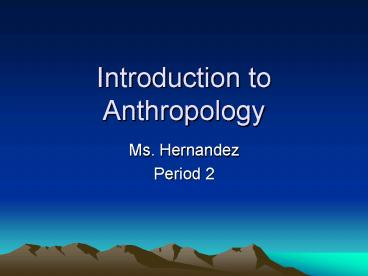Introduction to Anthropology - PowerPoint PPT Presentation
1 / 32
Title:
Introduction to Anthropology
Description:
Appearing in Asia and South East Asia (1st major migration) (Homoerectus- 5 feet tall) ... Homo sapiens spread overtaking Homo erectus. 50,000 ... – PowerPoint PPT presentation
Number of Views:235
Avg rating:3.0/5.0
Title: Introduction to Anthropology
1
Introduction to Anthropology
- Ms. Hernandez
- Period 2
2
Human Evolution Timeline
- 2.5 million years ago
- First man (Homohabilis) used stone tools
- 2 million years ago
- Humans control fire
- 1.7 million years ago
- Appearing in Asia and South East Asia (1st major
migration) (Homoerectus- 5 feet tall) - .5 million years ago
- Entering Europe (adapting to colder weather)
3
Human Evolution Timeline
- 200,00 years ago
- Homo sapiens in Europe adapt to modern man
- 100,000
- Homo sapiens spread overtaking Homo erectus
- 50,000
- Homo sapiens in Europe start having cultural
changes overtake physical. (complex use of
symbols/ language) - 15,000
- Homo sapiens in North America
4
Human Evolution Timeline
- 10,000
- earliest records of farming changing from
scavengers to producers (settlements begin) - 6,000
- writing/ city-states/ pyramids kings
- 3,000
- iron resources used, nation like
- 2,000
- Roman and Chinese Empire
5
What is Anthropology?
6
Anthropology
- Systematic way of understanding the human
experience and human diversity - Comprehensive study of past and present human
population and origin - Cross cultural comparison of all societies
- Ancient vs. Modern
- Small vs. Large
- Simple vs. Complex
7
Basic Definition
- Study of humankind over time and space
8
What makes Anthropology distinctive?
- Study all varieties of people
- Study humankind at all time periods
- Study all aspects of humanity (religion,
economics, food preferences, art, ecology,
gender, race, etc.) - Accept the unity of humanity. We are ALL similar
somehow.
9
Characteristics of Anthropology
- Holistic assumption that any aspect of a culture
is integrated with other aspects, so that no
dimension of culture can be understood in
isolation - Bio-cultural try to understand humans from a
biological and cultural existence- the PHYSICAL
and the SOCIAL
10
Ethnocentrism versus Cultural Relativism
- Perception of reality socially and
psychologically conditioned by culture
11
Ethnocentrism
- Ethnocentrism attitude or opinion that the
morals, values, and customs of ones own culture
are superior to those of other people - Attitude that a societys customs and ideas can
be judged within the context of ones own culture
12
Cultural Relativism
- Cultural Relativism the attitude that a
societys customs and ideas should be viewed
within the context of that societys ideals and
values
13
So much to cover! What to do? What to do?
- Subfields of Anthropology
14
Two Broad Classifications
- Biological/ Physical Anthropology study of human
biological variation and the emergence and
evolution of the human species - Cultural Anthropology study of recent and past
societies
15
Biological/ Physical Anthropology
16
Biological/ Physical Anthropology
- Human paleontology study of fossils and human
evolution
17
Biological/ Physical Anthropology
- Primatology study of primates (primarily for
purpose of clarifying evolutionary relationships)
18
Biological/ Physical Anthropology
- Population Genetics study of DNA structure and
the flow of genes amongst civilizations across
time and space
19
Cultural Anthropology
20
Cultural Anthropology
- Archaeology investigation of past cultures
through excavation of material remains
21
Cultural Anthropology
- Anthropological Linguistics focus on the
interrelationships between language and other
aspects of a peoples culture - Study of language
- How are languages different and/or similar?
- How has language evolved?
- How language is used socially?
22
Cultural Anthropology
- Ethnology study of human cultures from a
comparative perspective (study of how and why
recent cultures differ and are similar)
23
Applied Anthropology
- Concerned with applying information collected/
perspectives/ theories/ methods to contemporary
social problems and conditions (i.e., Public
Health, Family Planning, World Bank)
24
Medical Anthropology
- Falls under BOTH biological and cultural
anthropological domains - Biological study of disease variation across
populations - Cultural study of cultural interpretation of
disease (How humans react to their own sickness)
25
What is Culture?
26
What is Culture?
- Culture set of learned behaviors, beliefs,
attitudes, values, and ideals that are shared by
a particular society
27
Major Cultural Characteristics
- Learned
- Shared
- Symbolic
28
Culture is Learned
- Learned culture is learned through other members
of group - Socialization process internalizing meanings and
symbols used to interact and express thought - Learned by language, objects, reactions, etc.
29
Culture is Shared
- Shared through social interactions of groups-
learn from each other - Cooperative enterprise
30
Culture is Symbolic
- Symbolic meaning given to objects, events, and
concepts - Holidays (Halloween)
- Rituals (Sweet Sixteen)
- Behaviors (Sporting events)
- Objects (Computer)
- Food (Birthday cake)
31
What is Cultural Anthropology?
32
Cultural Anthropology
- Study of recent/ contemporary societies and
cultures in order to understand cultural
diversity - Explain behavioral variation within a culture and
across cultures































